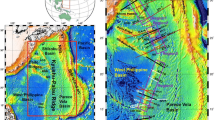Abstract
The upper mantle structures of Himalayas-Tibet have been obtained from the migration of receiver functions of the teleseismic events recorded by INDEPTH-III. The result of migration imaging shows a dipping interface subducting northward from the depth of 100 km to the 410-km discontinuity underneath southern Tibet. It indicates that the lithospheric mantle of the Indian continent had been detached from the crust and deeply subducted to the upper mantle of Eurasia during the Indo-Eurasian collision. This kind of continent-continent collision process is fundamentally different from the oceanic collision.
Similar content being viewed by others
References
Yin, A., Harrison, T. M., Geological evolution of the Himalaya-Tibetan orogeny, Annu. Rev. Earth Planet. Sci., 2000, 28: 211–280.
Lsacks, B. L., Oliver, L., Sykes, R., Seismology and the new global tectonics, J. Geophys. Res., 1968, 73: 5885–5900.
England, P. C., Houseman, G. A., Finite strain calculations of continental deformation, 2, comparison with the India-Asia collision, J. Geophys. Res., 1986, 91: 3664–3676.
Houseman, G.. A., England, P. C., A crustal-thickening model for the Indo-Asian collision, in the Tectonic Evolution of Asia ((eds. Yin, A., Harrison, T. M.), New York: Cambridge Univ. Press, 1996, 1–17.
Tapponnier, P., Molnar, P., Active faulting and tectonics in China, J. Geophys. Res., 1997, 82: 2905–2930.
Fu, R. S., Li, L. G., Huang, J. H. et al., Three-step model of the Qinghai-Xizang Plateau uplift, Chinese J. Geophys. (in Chinese), 1999, 42: 609–616.
Fu, R. S., Xu, Y. M., Huang, J. H. et al., Numerical simulation of the compression uplift of the Qinghai-Xizang Plateau, Chinese J. Geophys. (in Chinese), 2000, 43: 346–355.
Seeber, L., Ambruster, J. G., Quittmeyer, R. C., Seismicity and continental subduction in Himalayan arc, in Zagros, Hindu Kush, Himalaya, Geodynamic Evolution, Geodyn. Ser., Vol. 3 (eds. Gupta, H. K., Delany, F. M.), Washington: AGU, 1981, 215–242.
Barazangi, M., Ni, J., Propagation characteristics of Pn beneath the Himalayan and Tibetan plateau: possible evidence for underthrusting of Indian continental lithosphere beneath Tibet, Geology, 1982, 10: 179–185.
Ni, J., Barazangi, M., Seismotectonics of the Himalayan collision zone: Geometry of the underthrusting Indian plate beneath the Himalaya, J. Geophys. Res., 1984, 89: 1147–1163.
Mattauer, M., Intracontinental subduction, crust mantle decollement and crustal stacking wedge in the Himalaya and other collision belts, in Collision Tectonics ((eds. Coward, M. P., Ries, A. C.), London: Geol. Soc. Spec. Publ., 19, 1986, 35–60.
Beghoul, N., Barazangi, M., Isacks, B. L., Lithosphere structure of Tiber and western North America: Mechanics of uplift and a comparative study, J. Geophys. Res., 1993, 98: 1997–2016.
Matte, Ph., Mattauer, M., Oliver, J. M. et al., Continental subductions beneath Tibet and the Himalayan orogeny: a review, Terra nova, 1997, 9: 264–270.
Owens, T. J. Zandt, G.., Implications of crustal property variations for model of Tibetan Plateau evolution, Nature, 1997, 387: 37–43.
McKenzie, D. P., Speculation on the consequences and causes of plate motions, Geophys. J. Roy. Astr. Soc., 1969, 18: 1–32.
Willett, S., Beaumont, C., Fullsack, P., Mechanical model for the tectonics of doubly vergent compression orogens, Geology, 1993, 21: 371–374.
Hirn, A., Lepine, J. C., Jobert, G. et al., A crustal structure and variability of Himalaya border of Tibet, Nature, 1984, 307: 23–25.
Hirn, A., Nercessian, A., Sapin, M. et al., Lhasa block and bordering sutures-a continuation of a 500 km Moho traverse through Tibet, Nature, 1984, 307: 25–27.
Brown, L. D., Zhao, W., Nelson, K. D. et al., Bright spots, structure and magmatism in southern Tibet from INDEPTH seismic reflection profiling, Science, 1996, 274: 1688–1690.
Zhao, W. J., Nelson, K. D., Xu, Z. X. et al., Double intracontinental underthrusting structure of the Yarlung Zangbo suture and different molten layers-a comprehensive study of INDEPTH’s results,
Wu, Q. J., Zeng, R. S., The crustal structure of the Qinghai-Xizang Plateau inferred from broadband teleseismic waveforms, Chinese J. Geophys. (in Chinese), 1998, 41: 669–679.
Kind, R., Yuan, X., Saul, J. et al., Seismic Images of Crust and Upper Mantle beneath Tibet: Evidence for Eurasian plate subduction, Science, 2002, 298: 1219–1221.
Kosarev, G.., Kind, R., Sobolev, S. V. et al., Seismic evidence for a detached Indian lithospheric mantle beneath Tibet, Science, 1998, 283: 1306–1309.
Zeng, R. S., Ding, Z. F., Wu, Q. J. et al, Seismological evidences for the multiple incomplete crustal subductions in Himalaya and southern Tibet, Chinese J. Geophys. (in Chinese), 2000, 43: 780–797.
Brandon, C., Romanowicz, B., A “no-lid” zone in the central Chang-Tang platform of Tibet: Evidence from pure path phase velocity measurements of long-period Rayleigh waves, J. Geophys. Res., 1986, 91: 6547–6564.
Holt, W., Wallace, T., Crustal thickness and upper mantle velocities in the Tibetan Plateau region from the inversion of Pnl waveforms: Evidence for a thick upper mantle lid beneath southern Tibet, J. Geophys. Res., 1990, 95: 12, 499–12, 525.
Molnar, P., A review of geophysical constraints on the deep structure of the Tibetan Plateau the Himalaya and the Karakoram, and their tectonic interpretation, Philos. Trans. R. Soc. London. Ser. A, 1988, 357–396.
Turner, S., Hawksworth, J., Rogers, N. et al., Timing of the Tibetan uplift constrained by analysis of volcanic rocks, Nature, 1993, 364: 50–54.
Author information
Authors and Affiliations
Corresponding author
Rights and permissions
About this article
Cite this article
Wu, Q., Zeng, R. & Zhao, W. The upper mantle structure of the Tibetan Plateau and its implication for the continent-continent collision. Sci. China Ser. D-Earth Sci. 48, 1158–1164 (2005). https://doi.org/10.1360/03yd0556
Received:
Issue Date:
DOI: https://doi.org/10.1360/03yd0556




